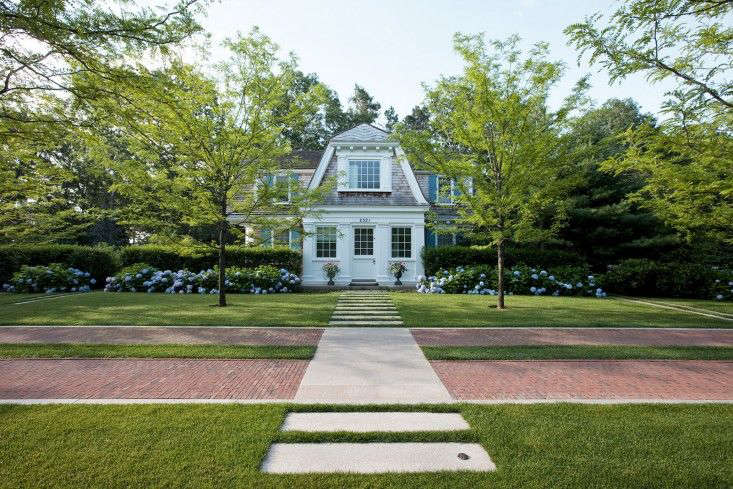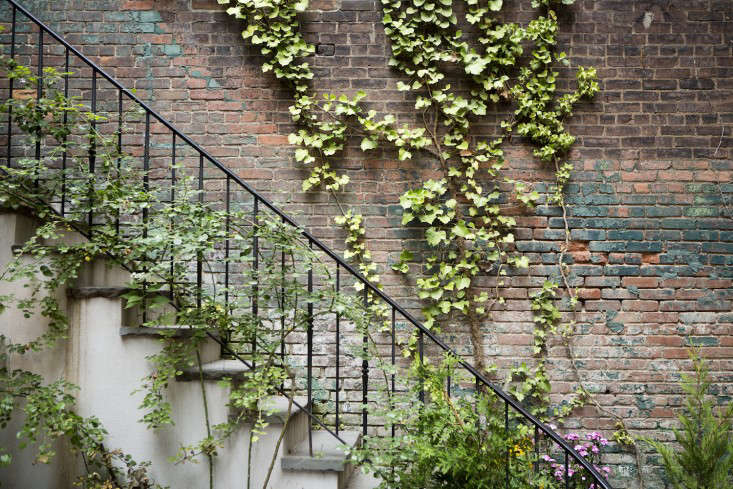A gracious style of driveway is making a comeback. Did you even know the ribbon driveway had a name? Read on for everything you need to know about environmentally friendly ribbon driveways.

When I was growing up in Memphis, we lived for a while in a little brick 1920s bungalow. A very prolific pecan tree grew beside the garage, and each fall we would gather the nuts from the spot where my dad parked the car–two strips of concrete with grass in between. Little did we know that we were harvesting pecans from a “ribbon” driveway.
What is a ribbon driveway?
Ribbon driveways, sometimes called Hollywood driveways, usually consist of two parallel tracks paved with a hard material and separated by an unpaved area. The tracks, or ribbons, are normally a couple of feet wide with a three-foot strip between them, though the proportions can vary to accommodate the sizes of different vehicles.

A water-permeable paved parking area employs brick on edge, dry-laid with granite edging in a design by Cape Cod landscape architecture firm Stephen Stimson Associates. For more, see Landscape Architect Visit: A Very American Garden on Cape Cod.
What is the history of ribbon driveways?
Apparently my family’s driveway was the height of fashion when our house was built. Ribbon driveways became popular in the 1920s. They were a natural progression from the ruts carved in the ground by the wheels of wagons and, later, automobiles. It makes sense that if you’re driving your vehicle from the street to the garage every day, you’d want to avoid wearing deep, muddy grooves into your lawn. The simplest and most economical way to do that: paving the areas where the wheels go and leaving the grass in the middle.

On Cape Cod, a ribbon driveway designed by andscape architecture firm Stephen Stimson Associates is crossed by a granite path, a visual cue to emphasize that pedestrians have the right-of-way here. For more, see Landscape Architect Visit: A Very American Garden on Cape Cod.
What are the benefits of a ribbon driveway?
- Ribbon driveways can easily be curved to fit the contours of the property where they’re being installed.
- Because they use less paving material, they usually cost less than a fully paved driveway.
- They offer a range of landscaping options: They can be constructed from a variety of paving materials, and the strip in the middle can be planted with any number of low-growing ground covers.
- They are a “green” solution, because they’re more permeable than solid driveways, allowing rainwater to be absorbed into the ground instead of draining into an overloaded sewer system.
- Ribbon driveways with planted centers are cooler in summer than concrete slabs and more pleasant to walk on.

What are the best materials for a ribbon driveway?
For the driving surface, the classic choice is concrete, which goes well with vintage Craftsman-style architecture. But crushed gravel, mortar-set brick or stone, cobblestones, oyster shells, or more modern interlocking pavers work well. Really, you could use any material that can withstand the weight of a moving vehicle and that complements the style of your house.
For the center strip, grass is typical. But you can also use a contrasting hard-surface material that requires less maintenance, such as stones or gravel. For a softer, more landscaped look, use mulch or any low-growing ground cover that will thrive in the light conditions. Old reliables like vinca minor, ajuga, or creeping phlox are good choices, as are herbs such as creeping thyme or rosemary. We’ve even seen succulents planted in the middle of a ribbon driveway.

What maintenance does a ribbon driveway need?
A major advantage of ribbon driveways is that, if correctly installed, they’re more flexible than a fully paved driveway in their response to the freeze-and-thaw cycle, and less prone to cracking from weather extremes. Of course, different materials have different requirements. Crushed gravel tends to scatter and may need to be topped up periodically. Center-strip plantings may require weeding, mowing, and/or watering. Snow removal can damage the plants, so you may find yourself replanting after a particularly harsh winter.

Below, a recap of the advantages and disadvantages of ribbon driveways.
Pros:
- Environmentally friendly. Allows for greater water absorption after downpours, which helps avoid overloading sewer systems.
- Attractive. Gives your property a greener, more landscaped look than a giant slab of concrete or blacktop.
- Flexible as far as placement goes–easily contoured to fit an irregular space.
- Low cost.
- Easily maintained; durable.
Cons:
- Can be difficult to maneuver. It’s hard to drive a long ribbon driveway in reverse.
- Plantings can be damaged by the wheels of vehicles that are wider than the paved strips.
- Mowing the grass in the middle can be problematic.
Interested in more driveway ideas? See Permeable Concrete Paver Driveways. Then there are Garage Flooring Options to consider.
Explore more ideas for patios, roofs, and fences in our Hardscaping 101 archive.












Have a Question or Comment About This Post?
Join the conversation (11)